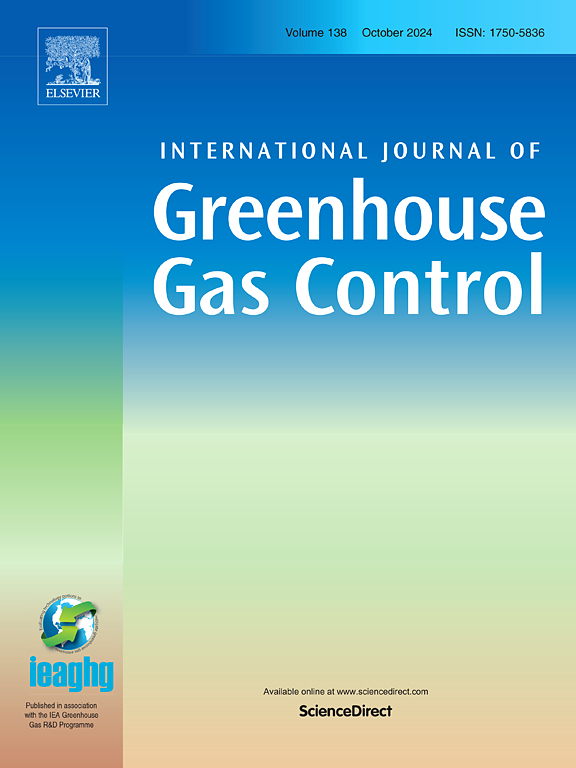Dissolved oxygen depletion catalyzed by amino acids in piperazine
IF 5.2
3区 工程技术
Q2 ENERGY & FUELS
International Journal of Greenhouse Gas Control
Pub Date : 2025-05-15
DOI:10.1016/j.ijggc.2025.104405
引用次数: 0
Abstract
Dissolved oxygen (DO) significantly influences the oxidative degradation of amine solvents used for CO2 capture from oxygen-containing gases. Amino acids are major degradation products in pilot testing of piperazine (PZ) solvent. This study used oxygen depletion to investigate the effect of metal ions and amino acids on amine oxidation in 5 m PZ. DO consumption was catalyzed by Fe3+ with a half-order dependency on Fe3+. A reaction order breakpoint occurred at 0.05 mM Fe³⁺, beyond which excess Fe³⁺ likely formed inactive clusters. Amino acids enhance the effective solubility and availability of monomeric Fe³⁺, amplifying its catalytic effect. Adding 0.05 mM ethylenediaminetetraacetic acid (EDTA) with 0.05 mM Fe³⁺ increased the rate constant for oxygen depletion from 0.53 h⁻¹ (clean 5 m PZ) to 6.5 h⁻¹. A plateau in DO consumption rate was seen at a critical Fe³⁺ concentration for each tested amino acid, beyond which additional Fe³⁺ became inactive. At lower Fe3+ (0.025 mM), amino acids such as nitrilotriacetic acid (NTA) sequestered Fe³⁺, reducing catalytic potential, while others enhanced it. This suggests that the role of amino acids is more complex than previously understood. Amino acids were ranked by their ability to increase DO consumption with 1 mM Fe³⁺ in 5 m PZ: 1 mM EDTA > 20 mM 1,2-di(piperazin-1-yl)ethan-1-one (PZAAPZ+) > 15 mM NTA > 15 mM N-(2-aminoethyl)glycine (AEG+) > 15 mM ethylenediaminediacetic acid (EDDA) > 15 mM glycine (GLY) > 15 mM iminodiacetic acid (IDA). In a degraded solvent sample from pilot plant testing, degradation products complex metal ions, enhancing their catalytic effects.
哌嗪中氨基酸催化的溶解氧耗竭
溶解氧(DO)显著影响用于从含氧气体中捕集CO2的胺类溶剂的氧化降解。在哌嗪(PZ)溶剂中试中,氨基酸是主要的降解产物。本研究采用缺氧法研究了金属离子和氨基酸对5 m PZ中胺氧化的影响。Fe3+对DO的消耗有半阶依赖性。反应顺序断点发生在0.05 mM的Fe³⁺,超过这个点,多余的Fe³⁺可能形成非活性簇。氨基酸增强了Fe³+单体的有效溶解度和可用性,增强了其催化作用。添加0.05 mM的乙二胺四乙酸(EDTA)和0.05 mM的Fe³⁺将氧气消耗的速率常数从0.53 h⁻¹(5 m毒血症)增加到6.5 h⁻¹。在每种被测氨基酸的临界Fe³⁺浓度下,DO消耗率呈平稳状态,超过该浓度后,额外的Fe³⁺就失去活性。在较低的Fe3+ (0.025 mM)下,硝酸三乙酸(NTA)等氨基酸会吸附Fe +,降低催化电位,而其他氨基酸则会增强催化电位。这表明氨基酸的作用比以前所理解的要复杂得多。用1 mM Fe³+在5 m PZ中增加DO消耗的能力对氨基酸进行排序:1 mM EDTA >;20 mM 1,2-二(哌嗪-1-基)ethan-1-one (PZAAPZ+) >;15 mM NTA >;15mm N-(2-氨基乙基)甘氨酸(AEG+) >;15mm乙二胺二乙酸(EDDA);15mm甘氨酸(GLY) >;15mm亚氨基二乙酸(IDA)。在中试工厂测试的降解溶剂样品中,降解产物络合金属离子,增强其催化作用。
本文章由计算机程序翻译,如有差异,请以英文原文为准。
求助全文
约1分钟内获得全文
求助全文
来源期刊
CiteScore
9.20
自引率
10.30%
发文量
199
审稿时长
4.8 months
期刊介绍:
The International Journal of Greenhouse Gas Control is a peer reviewed journal focusing on scientific and engineering developments in greenhouse gas control through capture and storage at large stationary emitters in the power sector and in other major resource, manufacturing and production industries. The Journal covers all greenhouse gas emissions within the power and industrial sectors, and comprises both technical and non-technical related literature in one volume. Original research, review and comments papers are included.

 求助内容:
求助内容: 应助结果提醒方式:
应助结果提醒方式:


